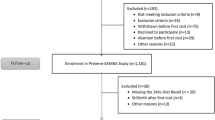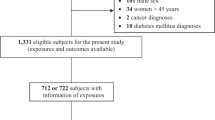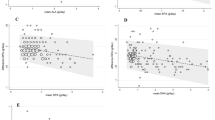Abstract
BACKGROUND/OBJECTIVES:
To assess the performance of a food frequency questionnaire (FFQ) for estimating ω-3, ω-6 and trans fatty acid intake during pregnancy. Moreover, we determined whether the fatty acid composition of mature breast milk represents a valuable biomarker for fatty acid intake during pregnancy.
SUBJECTS/METHODS:
A prospective study in 41 pregnant women, aged 18–35 years, was conducted. Food intake during pregnancy was evaluated by three 24-h recalls (24 hR), and 2 FFQ. The fatty acid composition of mature breast milk was determined by gas chromatography. The method of triads and joint classification between quartiles of intake were applied.
RESULTS:
The FFQ was accurate for estimating docosahexanoic (DHA), linoleic and total ω-6 fatty acids according to validity coefficients. Higher agreements (>70%) into the same or adjacent quartiles between the dietary methods were found for α-linolenic, total ω-3, linoleic and trans fatty acid intake. High validity coefficients for eicosapentanoic (EPA) and DHA acids of human milk were found (0.61 and 0.73, respectively), and the method was adequate for categorizing the intake of α-linolenic, total ω-3 and trans fatty acids compared with FFQ estimates, and for arachidonic acid and trans fatty acids compared with food recall estimates, during pregnancy.
CONCLUSIONS:
The FFQ was an accurate tool for categorizing α-linolenic, total ω-3 and trans fatty acid intake. According to the validity coefficients observed, the FFQ accurately estimated DHA, linoleic and total ω-6 fatty acids and the composition of mature breast milk was shown to be a suitable biomarker for EPA and DHA fatty acid intake during pregnancy.
This is a preview of subscription content, access via your institution
Access options
Subscribe to this journal
Receive 12 print issues and online access
$259.00 per year
only $21.58 per issue
Buy this article
- Purchase on Springer Link
- Instant access to full article PDF
Prices may be subject to local taxes which are calculated during checkout
Similar content being viewed by others
References
Meltzer HM, Brantsaeter AL, Nilsen RM, Magnus P, Alexander J, Haugen M . Effect of dietary factors in pregnancy on risk of pregnancy complications: results from the Norwegian Mother and Child Cohort Study. Am J Clin Nutr 2011; 4: 1S–5S.
Yajnik CS, Deshmukh US . Maternal nutrition, intrauterine programming and consequential risks in the offspring. Rev Endocr Metab Disord 2008; 9: 203–211.
Haggarty P . Fatty acid supply to the human fetus. Ann Rev Nutr 2010; 30: 237–255.
Larque E, Zamora S, Gil A . Dietary trans fatty acids in early life: a review. Early Human Dev 2001; 65: 31–41.
Decsi T, Campoy C, Demmelmair H, Szabó E, Marosvölgyi T, Escolano M et al. Inverse association between trans isomeric and long-chain polyunsaturated fatty acids in pregnant women and their newborns: data from three European countries. Ann Nutr Metab 2011; 59: 107–116.
Meltzer HM, Brantsaeter AL, Ydersbondi TA, Alexander J, Haugen M, The MoBa Dietary Support Group. Methodological challenges when monitoring the diet of pregnant women in a large study: experiences from the Norwegian Mother and Child cohort Study (MoBa). Matern Child Nutr 2008; 4: 14–27.
Pinto E, Ramos E, Severo M, Casal S, Dos Santos Silva I, Lopes C et al. Measurement of dietary intake of fatty acids in pregnant women: comparison of self-reported intakes with adipose tissue levels. Ann Epidemiol 2010; 20: 599–603.
Fawzi WW, Rifas-Shiman SL, Rich-Edwards JW, Willett WC, Gillman MW . Calibration of a semi-quantitative food frequency questionnaire in early pregnancy. Ann Epidemiol 2004; 14: 754–762.
Parra MS, Schnaas L, Meydani M, Perroni E, Martínez S, Romieu I . Erthocyte cell membrane phospholipid levels compared against reported dietary intakes of polyunsaturated fatty acids in pregnant Mexican women. Public Health Nutr 2002; 5: 931–937.
Brantsaeter AL, Haugen M, Thomassen Y, Ellingsen DG, Ydersbond TA, Hagve TA et al. Exploration of biomarkers for total fish intake in pregnant Norwegian women. Public Health Nutr 2009; 13: 54–62.
Mikkelsen TB, Osler M, Olsen SF . Validity of protein, retinol, folic acid and n-3 fatty acid intakes estimated from the food-frequency questionnaire udes in the Danish National Birth Cohort. Public Halth Nutr 2006; 9: 771–778.
Kaaks R . Biochemical markers as additional measurements in studies of the accuracy of dietary questionnaire measurements: conceptual issues. Am J Clin Nutr 1997; 65 (Suppl), 1232S–1239S.
Yokota RTC, Miyazaki ES, Ito MK . Applying the triads method in the validation of dietary intake using biomarkers. Cad Saúde Pública 2010; 26: 2027–2037.
Kabagambe EK, Baylin A, Allan DA, Siles X, Spiegelman D, Campos H . Application of the method of triads to evaluate the performance of food frequency questionnaires and biomarkers as indicators of long-term dietary intake. Am J Epidemiol 2001; 154: 1126–1135.
Brevik A, Vieierod MB, Drevon CA, Andersen LF . Evaluation of the odd fatty acids 15:0 and 17:0 in serum and adipose tissue as markers of intake of milk and dairy fat. Eur J Clin Nutr 2005; 59: 1417–1422.
McNaughton SA, Hughes MC, Marks GC . Validation of a FFQ to estimate the intake of PUFA using plasma phospholipid fatty acids and weighed food records. Br J Nutr 2007; 97: 561–568.
Zhang B, Wang P, Chen CG, He QQ, Zhuo SY, Chen YM et al. Validation of an FFQ to estimate the intake of fatty acids using erythrocyte membrane fatty acids and multiple 3 d dietary records. Public Health Nutr 2010; 13: 1546–1552.
Arab L, Akbar J . Biomarkers and the measurement of fatty acids. Public Health Nutr 2002; 5: 865–871.
Baylin A, Kabagambe EK, Siles X, Campos H . Adipose tissue biomarkers of fatty acid intake. Am J Clin Nutr 2002; 76: 750–757.
Van Goor SA, Dijck-Brouwer DA, Hadders-Algra M, Doornbos B, Erwich JJ, Schaafsma A et al. Human milk arachidonic acid and docosahexanoic acid contents increase following supplementation during pregnancy and lactation. Prostaglandins Leukot Essent Fatty Acids 2009; 80: 65–69.
Institute of Medicine. Weight Gain During Pregnancy: Reexamining the Guidelines. National Academy Press: Washington, 2009.
Cade J, Thompson R, Burley V, Warm D . Development, validation and utilization of food-frequency questionnaires- a review. Public Health Nutr 2002; 5: 567–587.
Barbieri P, Nishimura RY, Crivellenti LC, Sartorelli DS . Relative validation of a quantitative food frequency questionnaire for use in Brazilian pregnant women. Public Health Nutr 2012 e-pub ahead of print 16 August 2012.
Serra-Majem L, Andersen LF, Hénrique-Sánchez P, Doreste-Alonso J, Sánchez-Villegas A, Ortiz-Andrelluchi A et al. Evaluating the quality of dietary intake validation studies. Brit J Nutr 2009; 102: S3–S9.
Serra-Majem L, Nissensohn M, Overby NC, Fekete K . Dietary methods and biomarkers of omega 3 fatty acids: a systematic review. Br J Nutr 2012; 107: S64–S76.
ABEP Associação Brasileira de Empresa de Pesquisas [Brazilian Association of Research Institute]. Critério de Classificação Econômica Brasil [Brazilian Classification of Social Classes]. Available at http://www.abep.org (accessed January 2008).
Oliveira T, Marquitti FD, Carvalhaes MABL, Sartorelli DS . Desenvolvimento de um Questionário Quantitativo de Freqüência Alimentar (QQFA) para gestantes usuárias de unidades básicas de saúde de Ribeirão Preto, São Paulo, Brasil. [Development of a quantitative food frequency questionnaire for pregnant women attended by Primary Health Care in Ribeirão Preto, São Paulo State, Brazil] Cad Saúde Pública 2010; 26: 2296–2306.
Núcleo de Estudos e Pesquisa em Alimentação. Tabela Brasileira de composição de alimentos – TACO [Brazilian Food Composition Table]. Versão 2. 2a ed., Universidade Estadual de Campinas: Campinas, 2006.
United States Department of Agriculture Agricultural Research Service. USDA, Nutrient Database for Standard Reference 2001.
Bligh EG, Dyer WJ . A rapid method of total lipid extraction and purification. Can J Biochem Physiol 1959; 37: 911–917.
Ocké MC, Kaaks RJ . Biochemical markers as additional measurements in dietary validity studies: application of the method of triads with examples from the European prospective Investigation into Cancer and Nutrition. Am J Clin Nutr 1997; 65 (Suppl), 1240S–1245S.
Gil-Sánchez A, Demmelmair H, Parrilla JJ, Koletzko B, Larqué E . Mechanisms involved in the selective transfer of long chain polyunsaturated fatty acids to the fetus. Front Genet 2011; 2: 57.
Nyambose J, Koski KG, Tucker KL . High intra/interindividual variance ratios for energy and nutrient intakes of pregnant women in rural Malawi show that many days are required to estimate usual intake. J Nutr 2002; 132: 1313–1318.
Acknowledgements
This work was supported by fellowships from the Fundação de Amparo à Pesquisa do Estado de São Paulo, FAPESP, 2010/12320-1 (to RY Nishimura) and Coordenação de Aperfeiçoamento de Pessoal de Nível Superior, CAPES (to P Barbieri). Grant was obtained from the Fundação de Apoio ao Ensino Pesquisa e Assistência do Hospital das Clínicas da Faculdade de Medicina de Ribeirão Preto da Universidade de São Paulo, FAEPA.
Author information
Authors and Affiliations
Corresponding author
Ethics declarations
Competing interests
The authors declare no conflict of interest.
Rights and permissions
About this article
Cite this article
Sartorelli, D., Nishimura, R., Castro, G. et al. Validation of a FFQ for estimating ω-3, ω-6 and trans fatty acid intake during pregnancy using mature breast milk and food recalls. Eur J Clin Nutr 66, 1259–1264 (2012). https://doi.org/10.1038/ejcn.2012.127
Received:
Revised:
Accepted:
Published:
Issue Date:
DOI: https://doi.org/10.1038/ejcn.2012.127
Keywords
This article is cited by
-
Intake of arachidonic acid-containing lipids in adult humans: dietary surveys and clinical trials
Lipids in Health and Disease (2019)
-
Validation of a Food Frequency Questionnaire for Estimating Micronutrient Intakes in an Urban US Sample of Multi-Ethnic Pregnant Women
Maternal and Child Health Journal (2016)
-
The validity of a food frequency questionnaire as a measure of PUFA status in pregnancy
BMC Pregnancy and Childbirth (2015)
-
Validity and Reliability of Self-Reported Measures of Foods and Nutrients in Pregnancy: A Systematic Review
Current Nutrition Reports (2014)



